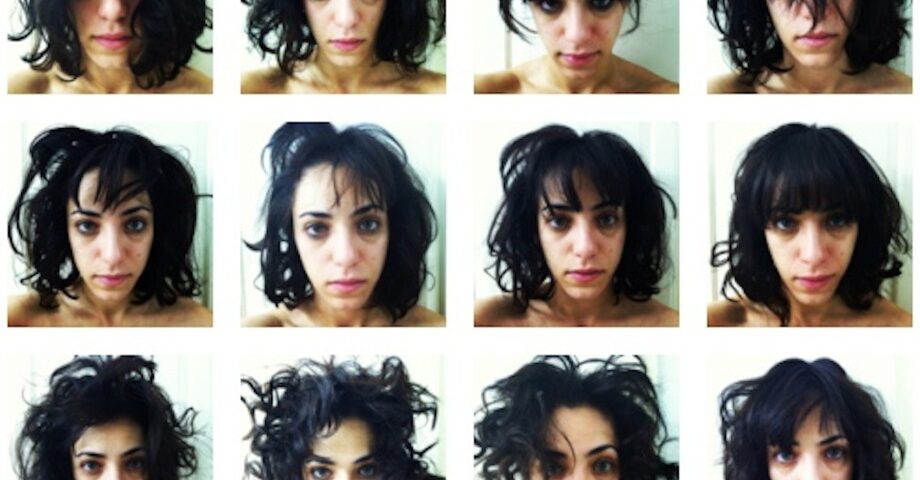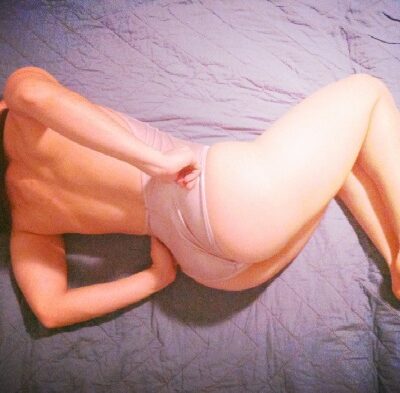

Danielle Georgiou
Danielle Georgiou’s intimate videos and photographs exploit and explore femininity and a desire to document beauty. They investigate the psychological effect of pop culture and social media on perceptions of the female body. These videos raise questions about what are acceptable behaviors in representations of women in popular entertainment, and what activities are condoned by contemporary social norms for women. By calling on female pop artists to provide the soundtrack to her life, Georgiou’s self-portraits are a direct response to her desire to be “perfect.”
Georgiou states, “#iwokeuplikethis is an installation of Stop-Motion Film and Large Scale Prints created in 2014. Using wall panels to break up the open space of the gallery, creating a maze-like pathway through the center of the space, I will project a stop-motion film of stills of my bed head. For nearly 150 days, I have been taking photographs at the moment that I wake up to capture the state of my hair and face.” She then uploads the raw image to her Instagram account, monitoring how many “likes” and comments each image receives.
Pulling inspiration from Beyoncé’s single, “Flawless,” which includes sections of a speech given by feminist writer Chimamanda Ngozi Adichie in which Adichie states that women are raised to see other women as competitors: “not for jobs or for accomplishments, which I think can be a good thing, but for the attention of men.” And even though she samples this speech, it’s as if Beyoncé is blind to Adichie’s message, because almost immediately following her sampling, Beyoncé sings, “bitches bow down” because she “woke up flawless.” In other words, she is better than everyone else and she has a power over men and women because of the way she looks. Her power lies in her physicality, which is supreme. Her body gives her power, and she, and all women, can use their bodies to control men.
Georgiou’s photographic and film series, #iwokeuplikethis, is a documentation of the beauty in the mundane. It is a tribute to physical honesty; it’s flawless in its purity. The technical nature of the images, the almost scientific quality of them, displays the method used to collect the data: the “selfie.”
The “selfie” is the most understood method of portraiture in popular culture today. It is both accessible and achievable. Anyone with a smart phone can take one, post it, and call it art. With #hashtag, Georgiou is exploring this trend and its iterations.
In another video, she dances in a shower, dissecting her body to only show her feet; a body part that is often seen as a point of fetish. Feet are a decisively feminine. Their shape, bone structure, and modes of articulation are one way to identify the feminine. They can lead you to truth and beauty and holiness: “Your word is a lamp to my feet and a light to my path” (Psalm 119:105). But they are also considered dirty and filthy: “And if your hand or your foot causes you to sin, cut it off and throw it away. It is better for you to enter life crippled or lame than with two hands or two feet to be thrown into the eternal fire” (Matthew 18:8). And yet, they can “lead us not into temptation, but deliver us from evil” (Matthew 6:13).
Wrestling with herself in a dance of resilient loneliness, will Georgiou be able to wash the sins of her past away? Or will they be forever trapped in a moving image?
And further speaking to this social media trend of Andy Warhol’s original 15 minutes of fame, Georgiou has publicized the most famous asset of them all: the derrière.
On March 3, 2014, this headline went viral: “#belfie Queen Goes High-Fashion.” In January 2014, 20-year-old Jen Selter rose to Instagram fame thanks to her large behind. Dubbed the Queen of the Belfie (or the butt-selfie), Selter, and her butt, have become huge—pun intended. She’s has signed with a modeling agency, appeared on The View and Good Morning America, partnered with a fitness company, and had a 2-page spread in the April 2014 issue of Vanity Fair.
In a series of 12 photographs, Georgiou presents herself as a #belfie model. Posed in a delicate manner, her face is purposefully hidden so that her performance in the images is focused on the body alone. It becomes something to be watched and used, and eventually sold. The trick behind selfies is the angle that you take it. From one angle you are considered beautiful, from another, it’s a monstrosity. What will Georgiou’s #belfies reveal?
In a final video, #bible, “The Need for Frank Knowledge of Sex Shown in Words and Pictures” is performed. Speaking the introduction to Dr. David H. Keller’s Picture Stories of the Sex Life of Man and Woman from 1946, Georgiou explores a repressed sexual knowledge in American culture.
_____________________________________________________________________________
Los vídeos y fotografías íntimos de Danielle Georgiou explotan y exploran la feminidad y el deseo de documentar la belleza. Investigan el efecto psicológico de la cultura pop y las redes sociales en las percepciones del cuerpo femenino. Estos videos plantean preguntas sobre cuáles son los comportamientos aceptables en las representaciones de mujeres en el entretenimiento popular y qué actividades son toleradas por las normas sociales contemporáneas para las mujeres. Al pedir a artistas pop femeninas que proporcionen la banda sonora de su vida, los autorretratos de Georgiou son una respuesta directa a su deseo de ser “perfecta”.
Georgiou afirma, “#iwokeuplikethis es una instalación de películas Stop-Motion e impresiones a gran escala creada en 2014. Usando paneles de pared para dividir el espacio abierto de la galería, creando un camino similar a un laberinto a través del centro del espacio, proyectar una película stop-motion de fotografías de mi cabecera de cama. Durante casi 150 días he estado tomando fotografías en el momento en que me despierto para capturar el estado de mi cabello y mi cara”. Luego sube la imagen sin editar a su cuenta de Instagram y monitorea cuántos “me gusta” y comentarios recibe cada imagen.
Inspirándose en el sencillo de Beyoncé, “Flawless” que incluye secciones de un discurso pronunciado por la escritora feminista Chimamanda Ngozi Adichie en el que Adichie afirma que las mujeres son educadas para ver a otras mujeres como competidoras: “ni por trabajos o logros que creo que pueden “Sería algo bueno, pero para la atención de los hombres”. Y aunque prueba este discurso, es como si Beyoncé estuviera ciega al mensaje de Adichie, porque casi inmediatamente después de su muestreo, Beyoncé canta, “bitches bow down” porque “despertó impecable”. En otras palabras, ella es mejor que todos los demás y tiene poder sobre hombres y mujeres debido a su apariencia. Su cuerpo le da poder y ella, y todas las mujeres, pueden usar sus cuerpos para controlar a los hombres.
Las series fotográfica y cinematográfica de Georgiou, #iwokeuplikethis, es una documentación de la belleza en lo mundano. Es un homenaje a la honestidad física; es impecable en su pureza. El carácter técnico de las imágenes, su calidad casi científica, muestra el método utilizado para recoger los datos: el “selfie”.
El “selfie” es el método de retrato más comprendido en la cultura popular actual. Es accesible y alcanzable. Cualquiera que tenga un teléfono inteligente puede tomar uno, publicarlo y llamarlo arte. Con #hashtag, Georgiou explora esta tendencia y sus iteraciones.
En otro video, baila en una ducha, diseccionando su cuerpo para mostrar solo sus pies; una parte del cuerpo que a menudo se considera un punto de fetiche. Los pies son decididamente femeninos. Su forma, estructura ósea y modos de articulación son una forma de identificar lo femenino. Pueden conducirte a la verdad, la belleza y la santidad: “Lámpara es a mis pies tu palabra y lumbrera a mi camino” (Salmo 119:105). Pero también son considerados sucios e inmundos: “Y si tu mano o tu pie te hacen pecar, córtalo y échalo de ti. Más te vale entrar en la vida manco o cojo, que con las dos manos o los dos pies ser arrojado al fuego eterno” (Mateo 18:8). Y, sin embargo, pueden “no dejarnos caer en la tentación, sino librarnos del mal” (Mateo 6:13).
Luchando consigo misma en una danza de soledad resistente, ¿podrá Georgiou lavar los pecados de su pasado? ¿O quedarán atrapados para siempre en una imagen en movimiento?
Y hablando además de esta tendencia en las redes sociales de los 15 minutos de fama originales de Andy Warhol, Georgiou ha publicitado el activo más famoso de todos: el trasero (the derrière).
El 3 de marzo de 2014, este titular se volvió viral: “#belfie Queen se vuelve de alta costura”. En enero de 2014, Jen Selter, de 20 años, saltó a la fama en Instagram gracias a su gran trasero. Apodada la Reina del Belfie (o el selfie del trasero), Selter y su trasero se han vuelto enormes-(juego de palabras). Ha firmado con una agencia de modelos, apareció en The View y Good Morning America, se asoció con una empresa de fitness y tuvo un artículo de dos páginas en la edición de abril de 2014 de Vanity Fair.
En una serie de 12 fotografías, Georgiou se presenta como modelo #belfie. Posada de manera delicada, su rostro se oculta a propósito para que su actuación en las imágenes se centre únicamente en el cuerpo. Se convierte en algo que se puede observar y utilizar, y finalmente vender. El truco detrás de los selfies es el ángulo en el que los tomas. Desde un ángulo te consideran hermosa, desde otro, es una monstruosidad. ¿Qué revelarán los #belfies de Georgiou?
En un vídeo final, #bible, “La Necesidad de un Conocimiento Franco del Sexo Mostrado en Palabras e Imágenes”. Hablando en la introducción a las Historias de imágenes de la vida sexual del hombre y la mujer del Dr. David H. Keller de 1946, Georgiou explora un conocimiento sexual reprimido en la cultura estadounidense.






